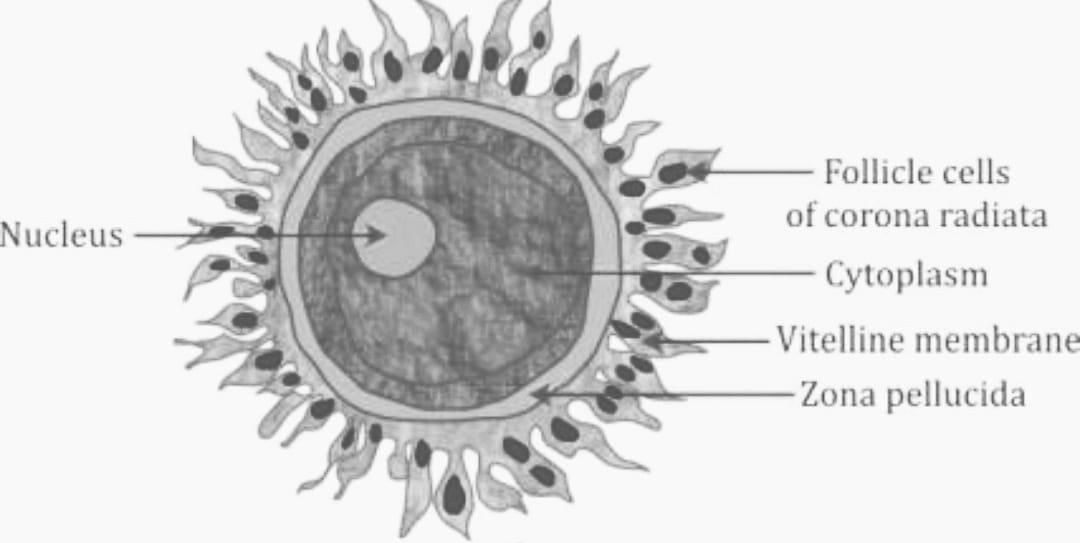
Draw a labeled diagram of a human ovum just released by the mature Graafian follicle.
Answer
570k+ views
Hint: The graafian follicle ruptures and a ovum is released in the ovulatory phase of menstrual cycle. It has two layers that protect the egg and also has a large nucleus.
Complete step by step answer:
The ovum is the female gamete in humans which is fertilized by the sperm (male gamete). The ovum is released by the ovary. The ovary has primordial follicle which develops into graafian follicle by secretion of FSH during the proliferative phase. Then, when there is release of LH, the graafian follicle ruptures and releases the ovum into the fallopian tube during ovulation that occurs on days of menstrual cycle.
The ovum has two protective layers: outer, thicker, cellular - corona radiata ; inner, thinner, non-cellular - zona pellucida. The plasma membrane of the ovum cell is called vitelline membrane which lies under zona pellucida.

The cytoplasm is differentiated into outer, smaller exoplasm or egg cortex and inner larger, ooplasm or endoplasm. The ooplasm has a large nucleus called the germinal vesicle. The ovum lacks centrioles and has two poles called vegetal pole and polar body animal pole.
There is a narrow perivitelline space between vitelline membrane and zona pellucida.
Note:
The ovum cell is the largest cell of the mammalian body in diameter. The ovum is released by matured graafian follicle only and waits for entry of sperm to get fertilized. If not fertilized, there is an exit of the ovum with all prepared endometrial glands and an unfertilized ovum with 35 to 45 mL of blood is called menstruation.
Complete step by step answer:
The ovum is the female gamete in humans which is fertilized by the sperm (male gamete). The ovum is released by the ovary. The ovary has primordial follicle which develops into graafian follicle by secretion of FSH during the proliferative phase. Then, when there is release of LH, the graafian follicle ruptures and releases the ovum into the fallopian tube during ovulation that occurs on days of menstrual cycle.
The ovum has two protective layers: outer, thicker, cellular - corona radiata ; inner, thinner, non-cellular - zona pellucida. The plasma membrane of the ovum cell is called vitelline membrane which lies under zona pellucida.

The cytoplasm is differentiated into outer, smaller exoplasm or egg cortex and inner larger, ooplasm or endoplasm. The ooplasm has a large nucleus called the germinal vesicle. The ovum lacks centrioles and has two poles called vegetal pole and polar body animal pole.
There is a narrow perivitelline space between vitelline membrane and zona pellucida.
Note:
The ovum cell is the largest cell of the mammalian body in diameter. The ovum is released by matured graafian follicle only and waits for entry of sperm to get fertilized. If not fertilized, there is an exit of the ovum with all prepared endometrial glands and an unfertilized ovum with 35 to 45 mL of blood is called menstruation.
Recently Updated Pages
Master Class 12 Social Science: Engaging Questions & Answers for Success

Master Class 12 Physics: Engaging Questions & Answers for Success

Master Class 12 Maths: Engaging Questions & Answers for Success

Master Class 12 Economics: Engaging Questions & Answers for Success

Master Class 12 Chemistry: Engaging Questions & Answers for Success

Master Class 12 Business Studies: Engaging Questions & Answers for Success

Trending doubts
What are the major means of transport Explain each class 12 social science CBSE

Which are the Top 10 Largest Countries of the World?

Draw a labelled sketch of the human eye class 12 physics CBSE

How much time does it take to bleed after eating p class 12 biology CBSE

Explain sex determination in humans with line diag class 12 biology CBSE

Explain sex determination in humans with the help of class 12 biology CBSE




